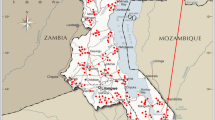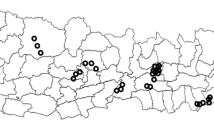Abstract
Background
There is limited evidence to characterize the burden of unmet need of surgical diseases in low- and middle-income countries. The purpose of this study was to determine rate of deaths attributable to a surgical condition and reasons for not seeking surgical care in Sierra Leone.
Methods
The Surgeons OverSeas Assessment of Surgical Need (SOSAS) is a survey tool developed collaboratively to be used for cross-sectional data collection of the prevalence of surgical conditions in any country. A population-weighted cluster-sample household survey was conducted throughout Sierra Leone in 2012 using the SOSAS survey tool.
Results
Total of 1,840 households (11,870 individuals) were sampled, yielding a 98.3 % response rate. Overall, there were 709 total deaths reported (6.0 %). The mean age at death was 36.4 ± 30.1 years: 330 (46.6 %) were female. Most deaths occurred at home (58.1 % vs. 34.1 % in hospitals). Of the 709 deaths, 237 (33.4 %) were associated with conditions included in our predefined surgical disease category. Abdominal distension/pain was the most commonly associated surgical condition (13.9 %) followed by perinatal bleeding/illness (6.0 %). Among the 237 with surgical conditions, 51 (21.9 %) did not seek medical care, most commonly because of a lack of money (35.3 %) or inability to provide timely care (37.3 %).
Conclusions
A large proportion of deaths in Sierra Leone was associated with surgical conditions, the majority of which did not undergo surgical intervention. Our results indicate that to remove barriers to effective surgical care in Sierra Leone policymakers should first focus on relieving financial burdens and increasing access to timely surgical care.
Similar content being viewed by others

References
Debas HT, Gosselin R, McCord C, Thind A (2006) Disease control priorities in developing Countries. Oxford University Press, New York, pp 1245–1259
Weiser TG, Regenbogen SE, Thompson KD et al (2008) An estimation of the global volume of surgery: a modelling strategy based on available data. Lancet 372:139–144
Ahmed M, Shah M, Luby S et al (1999) Survey of surgical emergencies in a rural population in the northern areas of Pakistan. Trop Med Int Health 4:846–857
Anonymous (2011) Causes of Death 2008: data sources and methods. Department of Health Statistics and Informatics, World Health Organization. Available at: http://www.who.int/healthinfo/global_burden_disease/cod_2008_sources_methods.pdf/. Accessed 19 May 2012
Groen RS, Samai M, Stewart KM et al (2012) Untreated surgical conditions in Sierra Leone: a cluster randomised, cross-sectional, countrywide survey. Lancet 380:1082–1087
Groen RS, Samai M, Petroze RT et al (2012) Pilot testing of a population-based surgical survey tool in Sierra Leone. World J Surg 36:771–774. doi:10.1007/s00268-012-1448-9
Henderson RH, Sundaresan T (1982) Cluster sampling to assess immunization coverage: a review of experience with a simplified sampling method. Bull World Health Organ 60:253–260
Bennett MJ (1982) Cluster of uncommon fetal abnormalities. Lancet 1:1360–1361
Bennett S, Woods T, Liyanage WM et al (1991) A simplified general method for cluster-sample surveys of health in developing countries. World Health Stat Q 44:98–106
Contini S (2007) Surgery in developing countries: why and how to meet surgical needs worldwide. Acta Biomed 78:4–5
Paxton A, Maine D, Freedman L et al (2005) The evidence for emergency obstetric care. Int J Gynaecol Obstet 88:181–193
Spiegel DA, Gosselin RA (2007) Surgical services in low-income and middle-income countries. Lancet 370:1013–1015
Gosselin RA, Spiegel DA, Coughlin R et al (2009) Injuries: the neglected burden in developing countries. Bull World Health Organ 87:246–246a
McQueen KA, Parmar P, Kene M et al (2009) Burden of surgical disease: strategies to manage an existing public health emergency. Prehosp Disaster Med 24(Suppl 2):s228–s231
Blanchard RJ, Blanchard ME, Toussignant P et al (1987) The epidemiology and spectrum of surgical care in district hospitals of Pakistan. Am J Public Health 77:1439–1445
Holmberg S, Nordberg E (1990) Surgical rates in Africa: variations and their possible explanations. Trop Geogr Med 42:352–358
Weiser TG, Makary MA, Haynes AB et al (2009) Standardised metrics for global surgical surveillance. Lancet 374:1113–1117
Dikshit R, Gupta PC, Ramasundarahettige C et al (2012) Cancer mortality in India: a nationally representative survey. Lancet 379:1807–1816
Mock C, Joshipura M, Quansah R et al (2007) Advancing injury prevention and trauma care in North America and globally. Surg Clin North Am 87:1–19
Ronsmans C, Holtz S, Stanton C (2006) Socioeconomic differentials in caesarean rates in developing countries: a retrospective analysis. Lancet 368:1516–1523
Nordberg EM (1984) Incidence and estimated need of caesarean section, inguinal hernia repair, and operation for strangulated hernia in rural Africa. Br Med J (Clin Res Ed) 289:92–93
Anonymous (2009) WHO Country Focus on Sierra Leone. Country Cooperation Strategy at a Glance. World Health Organization. Available at: http://www.who.int/countryfocus/cooperation_strategy/ccsbrief_sle_en.pdf/. Accessed 26 May 2012
Author information
Authors and Affiliations
Corresponding author
Electronic supplementary material
Below is the link to the electronic supplementary material.
Rights and permissions
About this article
Cite this article
Kwon, S., Groen, R.S., Kamara, T.B. et al. Nationally Representative Household Survey of Surgery and Mortality in Sierra Leone. World J Surg 37, 1829–1835 (2013). https://doi.org/10.1007/s00268-013-2035-4
Published:
Issue Date:
DOI: https://doi.org/10.1007/s00268-013-2035-4



